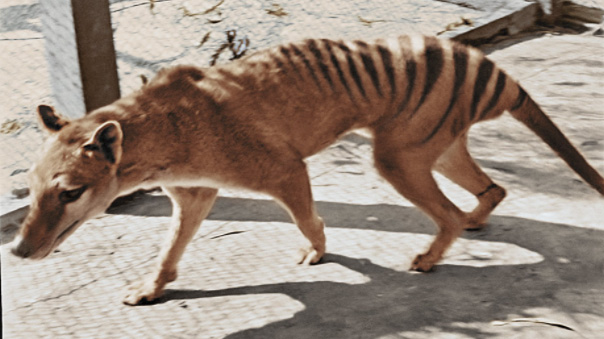
Australia is one step closer to bringing back the long-extinct Tasmanian tiger.
Breakthrough research into the Aussie marsupial, known by its scientific name thylacine, has uncovered an almost exact genomic DNA blueprint of the tigers.
Tasmanian tigers were wiped out in 1936 but researchers in Texas and Melbourne announced they have made “incredible scientific leaps” in recreating ancient DNA cells.
READ MORE: What we know about the death of former One Direction star Liam Payne
Scientists at bioscience company Colossal said the thylacine genome is 99.9 per cent accurate and is a world-first for an extinct species.
It’s something the world’s brightest minds thought would “never be achieved”.
“The thylacine samples used for our new reference genome are among the best preserved ancient specimens my team has worked with,” Beth Shapiro, Colossal’s Chief Science Officer and the Director of the UCSC Paleogenomics Lab, said.
“It’s rare to have a sample that allows you to push the envelope in ancient DNA methods to such an extent.
“We’ve delivered a record-breaking ancient genome that will accelerate our thylacine de-extinction project.”
The breakthrough was in part thanks to DNA and soft tissue taken from a 110-year-old Tasmanian tiger.
READ MORE: Severe thunderstorms to hit parts of Australia’s south-east
A completely preserved head from the historic animal meant scientists could take samples from major DNA hubs such as tongues, brain, eye and nasal cavities.
Tasmanian tigers had a distinctive jaw and skull shape, which are similar to that found in wolves and dogs.
“We’re beyond pleased to learn that these regions of the genome are impacting the craniofacial phenotype as we predicted,” Sara Ord, Director of Species Restoration at Colossal Biosciences, said.
“This is crucial evidence of the power of Colossal’s approach and an important step toward thylacine de-extinction.”
READ MORE: Beaches remain closed as clean-up of black ‘tar’ balls continues
Dr Andrew Pask, head of the research at the University in Melbourne, said the team was getting closer to re-introducing the Tasmanian tiger back to the ecosystem.
“It’s incredible to see how all these new technologies (ART, iPSC derivation, marsupial gene editing) are already being used to solve major conservation issues for marsupials, as well hitting all of our major milestones for bringing back the thylacine.”
In another world first, the team have succeeded in taking fertilised single-cell embryos and taken them halfway through pregnancy in an artificial uterus.
“This is far beyond any previous attempts to grow embryos for any marsupial,” Colossal said in a statement.
The thylacine disappeared about 2000 years ago virtually everywhere except Tasmania.
The last thylacine living in captivity, named Benjamin, died from exposure in 1936 at the Beaumaris Zoo in Hobart.
links to content on ABC
9News





